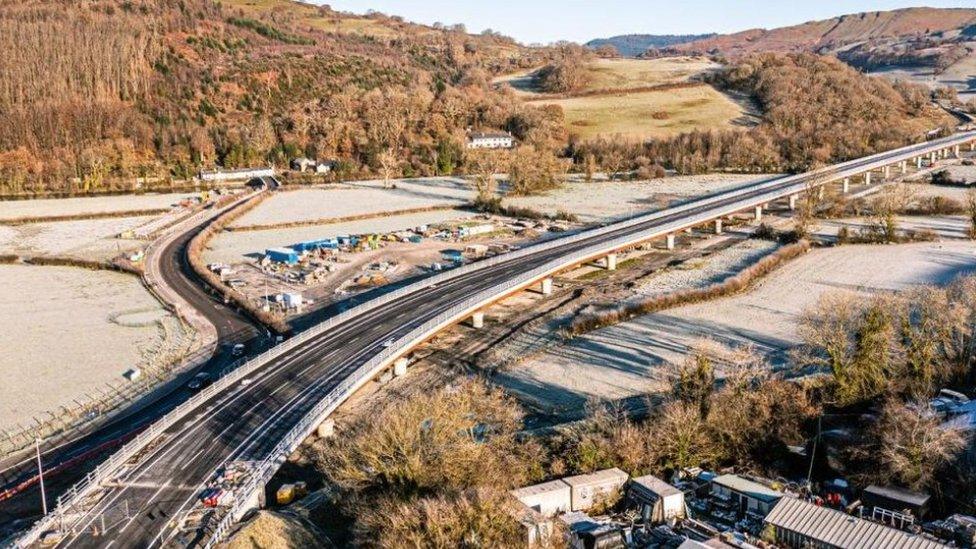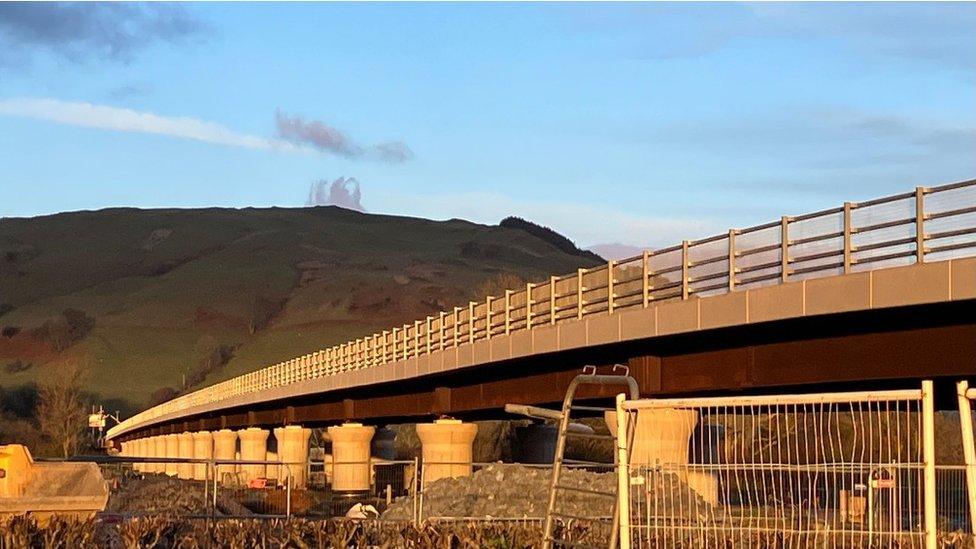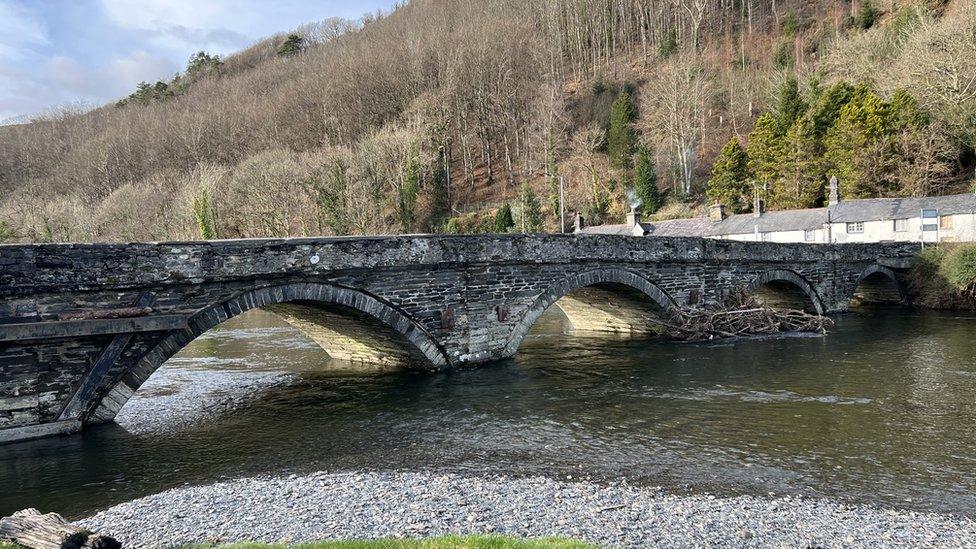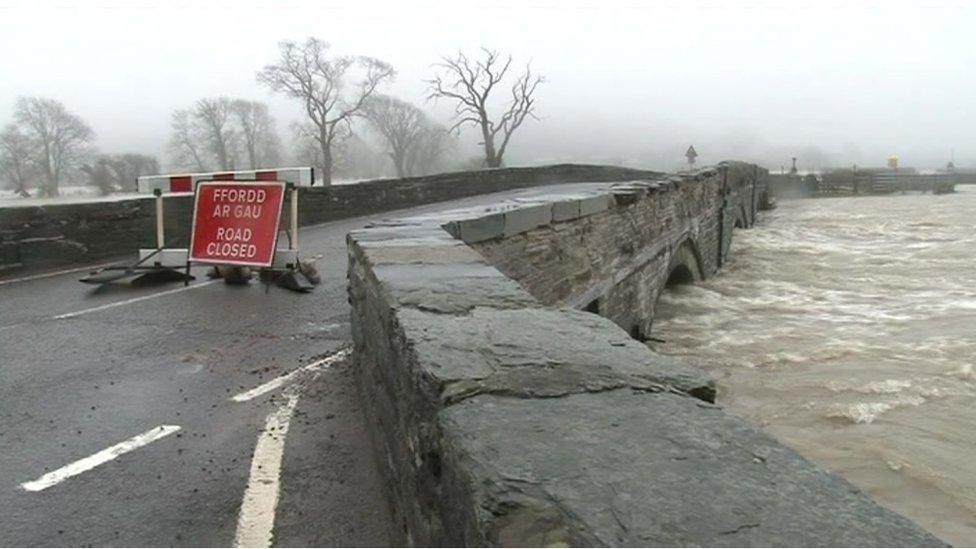Dyfi bridge: New road opens tackling long diversion
- Published

Deputy Climate Change Minister Lee Waters joins children crossing the bridge
A new bridge linking north and south Wales has opened after more than two-and-a-half years of work.
The structure over the River Dyfi in Powys cost £46m and replaces an old stone bridge often closed by flooding, sending drivers on a 12-mile diversion.
A haulage company whose lorries pass Machynlleth 40 times a day said it solved one of two bottlenecks it faces in Wales.
Scott Mansel Davies said the other was Newport's Brynglas tunnels.
His company MDS Distribution, whose tankers collect milk across Wales, said these two stretches make drivers' lives difficult.

The stretch was described by one haulier of one of two big bottlenecks in Wales
The tunnels in Newport have previously been criticised as the most-congested stretch of inner city motorway in the UK away from the M25, although works have since taken place to try to improve the road.
"Machynlleth has been a bottleneck over the years and it's probably one of two bottlenecks on the roads of Wales. The other one would have to be the Brynglas tunnels on the M4 corridor," Mr Mansel Davies said.
"With those two bottlenecks sorted it would make our lives easier as a haulier. One is sorted now, let's cross our fingers for Brynglas."
He said the diversion, which happens regularly with heavy rain, was a "big headache".

Scott Mansel Davies says one of two bottlenecks in Wales have been tackled
"We've had issues in the planning office with having to rearrange work and redivert drivers," he added.
"The drivers also have the issue of going around Dinas Mawddwy, a far more challenging road and an additional 10 miles and additional 30 minutes out of their scheduling. Which as you can imagine, costs a lot of money but also causes a big headache."
The new road is 1.2km (0.7 miles) and includes a 725m (2,378ft) viaduct which sits nine metres (20ft) above the River Dyfi floodplain.
New flood prevention measures have also been built to protect the Dyfi Eco Park and a road leading to Machynlleth town centre that passes under a railway line, with emergency surface water pumps installed.
In February last year, the Welsh government said all future road projects must pass strict criteria, external which means they must not increase carbon emissions, the number of cars on the roads, or negatively impact the environment.
While the Dyfi bridge project meets those requirements, work began in spring 2021 before the review panel was appointed and does not come as a result of the roads review.

The new bridge opened on Friday
Lee Waters, the Welsh government deputy minister with responsibility for transport, formally opened the new bridge on Friday.
"Our roads policy statement published last year makes clear that we will continue to invest in new and existing roads, but to qualify for future funding the focus must be on minimising carbon emissions, not increasing capacity; not increasing emissions through higher vehicle speeds, and not adversely affecting ecologically valuable sites," he said.
Machynlleth mayor Jeremy Paige said it had been a long wait.
"I think I represent a lot of people when I say we're so pleased that we're getting to a situation where it's going to be open and available to all and the disruption from flooding is removed from this town," he said.
Michael Williams, who has represented Machynlleth on Powys council since 1980 and has been a town councillor since 1974, said he remembered discussions about a replacement bridge beginning decades ago.
"I didn't think that I would ever see a new bridge because of cost," he said.
"It will encourage people to come into the area for holidays and people won't have to worry about huge delays when the road is flooded."

The old bridge had to shut regularly due to flooding leaving drivers with long diversions
What is the history of the Dyfi bridge?
The old Dyfi bridge was built in 1805, and according to Mr Williams, the history books say it cost £400 - with the counties of Montgomeryshire and Meirionnydd contributing half each.
"The current bridge was built the year of (the Battle of) Trafalgar, in 1805," he said.
"And I'm pretty sure there weren't many articulated lorries in 1805."

TOURIST TRAP: Meet the team selling Wales to the world
FOR THE LOVE OF SPORT: The biggest names in Welsh sport and the stories behind them

Related topics
- Published7 October 2015

- Published12 January 2024
